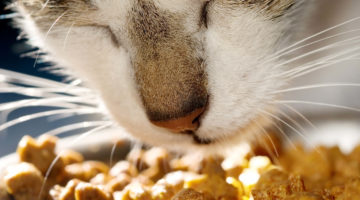Raw bones help keep your cat’s teeth clean and her gums healthy, but it’s important to give her the right kind. Poultry necks are the best choice – here’s why.
Your cat’s dental health can have a big impact on her overall well being, so it’s important to make sure her teeth and gums are in good condition. One way to do this is to give her raw bones to chew on. But not just any bones.
In the neck
Raw poultry necks are the best bones for cats, and can play an integral role in their dental hygiene. Necks are made up of cartilage, ligaments and tendons that act as a form of natural dental floss, while chewing the muscle meat can also help keep teeth clean. The process of grinding and crushing the cartilage actually massages the cat’s teeth and gums, cleaning away food residues and helping eliminate tartar development. This in turn prevents plaque formation, bad breath, dental cavities and gingivitis.
Because poultry necks are made of cartilage rather than bone, they’re soft and spongy rather than hard. Easy to find varieties include chicken, Cornish game hen, turkey and duck necks. Smaller cats may like Cornish game hen necks. In fact, these smaller necks often serve as a good first bone for any cat. Once she becomes accustomed to them, she might prefer the meatier turkey and duck necks.
Larger poultry necks can also be cut into smaller, easy to handle pieces. Turkey necks can be cut into half a dozen pieces and then sliced in half again, yielding a semicircular tube. Duck and chicken necks can be cut into a few portions. As your cat gets used to handling and chewing on the necks, you can increase the size of the pieces.
If you’re cutting up the necks, be sure not to go too far and make the pieces too small. While our finicky felines are less likely than dogs to gobble down an entire hunk of neck, it’s best to avoid bones of a size that will tempt them to swallow without chewing first. After all, it’s the chewing that cleans their teeth.
Introducing raw bones
Some cats will go into overdrive at first sight of a poultry neck, just as if they’re auditioning for a part in Born Free. Our little carnivores instinctively know how to crush and chew a bone! It’s a good idea to get kittens started young with poultry necks so their teeth stay healthy.
It might be difficult to get some adult cats eating bones if they’re not used to fresh meat or already have bad teeth or a dental problem. If your cat displays any discomfort with raw necks, have your veterinarian do a thorough dental exam. When cats have a great deal of tartar and gum recession, it’s not a bad idea to have their teeth checked and cleaned first, then use poultry necks to continue maintaining dental health.
If your cat remains unimpressed with your new and wonderful idea, entice her by sprinkling a little tuna juice on the necks the first few times. You can also sprinkle the necks with dry powdered liver or catnip, or rub some canned food on them. A finicky feline may require a few attempts, but don’t give up.
No cooking
Poultry necks make ideal snacks for your cat. Never cook or microwave them!
Never cook and never microwave poultry necks. The benefits of eating bones are greatly reduced by cooking them, and it can actually create dangers. Poultry necks are safe for cats because they’re made of spongy cartilage; cooking them renders them tougher and more brittle, which means they’ll break apart into large chunks more easily. Your cat might swallow a piece that’s too large to digest, necessitating a trip to the veterinarian. Cooking also changes the natural calcium so it is almost unavailable for absorption, doing away with that vital source of mineral availability. Microwaving is ever worse: it denatures the protein, destroys the natural enzymes, and also renders the calcium in the bone unusable by the body.
If you have a cat with a gastrointestinal problem or impaired immune system, and you’re worried about bacteria, drop the neck in a pot of boiling water for a second. (Most cats like their food better if it’s not cold from the refrigerator anyhow, so you can always place the neck in some warm water or drop it – for just a second – into hot or boiling water.) My cats like it when I cut a chicken neck into a few pieces, turn on the broiler and put the pieces in the oven for just a second or two on each side. Again, never leave the necks to cook for a long time; it makes the cartilage hard and the necks will not digest easily.
However you decide to serve poultry necks, supervise your cat while she’s chewing them until you know she’s got the drill down pat.
I’ve been recommending poultry necks for over 25 years, both as a healthy and delicious snack and as a preventive dental measure. I have never encountered a problem with my patients eating them. In fact, most commercial feline treats are loaded with synthetic ingredients I would not recommend, while poultry necks provide cats with healthy and essential nutrition.
Most adult cats will happily eat a poultry neck every day, but even twice weekly will give her dental protection. Either way, it’s all for the best if your cat decides that poultry necks are the highlight of her day. They’re easy to find, inexpensive, easy to prepare and healthy to boot. And you know the old saying: “A poultry neck a day keeps the dentist away!”
They’re good for her!
Poultry necks provide your cat with nutritional as well as dental support.
- The calcium in raw necks is more digestible than most common calcium supplements.
- A chicken or turkey neck has a calcium/phosphorus ratio of about 1.75 to 1.00.
- Poultry necks contain protein, potassium, zinc, copper, magnesium and manganese.
- They give cats a much-needed external source of arginine, an essential amino acid.
How can raw bones benefit dogs? Take a look!







No Comment